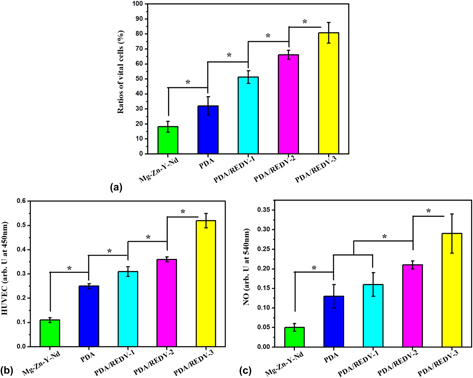Crossref Citations
This article has been cited by the following publications. This list is generated based on data provided by
Crossref.
Han, Congzhen
Luo, Xiao
Zou, Dan
Li, Jingan
Zhang, Kun
Yang, Ping
and
Huang, Nan
2019.
Nature-inspired extracellular matrix coating produced by micro-patterned smooth muscle and endothelial cells endows cardiovascular materials with better biocompatibility.
Biomaterials Science,
Vol. 7,
Issue. 7,
p.
2686.
Xu, Ru
Su, Chen
Cui, Longlong
Zhang, Kun
and
Li, Jingan
2019.
Preparing Sodium Alginate/Polyethyleneimine Spheres for Potential Application of Killing Tumor Cells by Reducing the Concentration of Copper Ions in the Lesions of Colon Cancer.
Materials,
Vol. 12,
Issue. 9,
p.
1570.
Ma, Wenyong
Liu, Luying
luo, Xiao
Han, Congzhen
Yang, Ping
Zhao, Yuancong
and
Huang, Nan
2019.
Effects of biomimetic micropattern on titanium deposited with PDA/Cu and nitric oxide release on behaviors of ECs.
Journal of Materials Research,
Vol. 34,
Issue. 12,
p.
2037.
Wang, Shuo
Zhang, Xueqi
Li, Jingan
Liu, Changsheng
and
Guan, Shaokang
2020.
Investigation of Mg–Zn–Y–Nd alloy for potential application of biodegradable esophageal stent material.
Bioactive Materials,
Vol. 5,
Issue. 1,
p.
1.
Li, Jing-an
Chen, Li
Zhang, Xue-qi
and
Guan, Shao-kang
2020.
Enhancing biocompatibility and corrosion resistance of biodegradable Mg-Zn-Y-Nd alloy by preparing PDA/HA coating for potential application of cardiovascular biomaterials.
Materials Science and Engineering: C,
Vol. 109,
Issue. ,
p.
110607.
Zhang, Kun
Bai, Yuxin
Xu, Ru
Li, Jingan
and
Guan, Fangxia
2020.
The mechanism of PDA/PEI/5‐Fu coated esophageal stent material on inhibiting cancer associated pathological cells.
Journal of Biomedical Materials Research Part A,
Vol. 108,
Issue. 3,
p.
814.
Mei, Di
Lamaka, Sviatlana V.
Lu, Xiaopeng
and
Zheludkevich, Mikhail L.
2020.
Selecting medium for corrosion testing of bioabsorbable magnesium and other metals – A critical review.
Corrosion Science,
Vol. 171,
Issue. ,
p.
108722.
Wu, Yuxiang
Chang, Lei
Li, Jingan
Wang, Liguo
and
Guan, Shaokang
2020.
Conjugating heparin, Arg–Glu–Asp–Val peptide, and anti-CD34 to the silanic Mg–Zn–Y–Nd alloy for better endothelialization.
Journal of Biomaterials Applications,
Vol. 35,
Issue. 2,
p.
158.
Ding, Yilei
Zhao, An-sha
Liu, Tianmei
Wang, Ya-nan
Gao, Yuan
Li, Jing-an
and
Yang, Ping
2020.
An Injectable Nanocomposite Hydrogel for Potential Application of Vascularization and Tissue Repair.
Annals of Biomedical Engineering,
Vol. 48,
Issue. 5,
p.
1511.
Wang, Zhan
Zhu, Shijie
Wang, Liguo
Chang, Lei
Wang, Jun
Li, Jingan
and
Guan, Shaokang
2020.
Preparing a novel magnesium‐doped hyaluronan/polyethyleneimine nanoparticle to improve endothelial functionalisation.
IET Nanobiotechnology,
Vol. 14,
Issue. 2,
p.
142.
Li, Chang-Yang
Gao, Ling
Fan, Xiao-Li
Zeng, Rong-Chang
Chen, Dong-Chu
and
Zhi, Ke-Qian
2020.
In vitro degradation and cytocompatibility of a low temperature in-situ grown self-healing Mg-Al LDH coating on MAO-coated magnesium alloy AZ31.
Bioactive Materials,
Vol. 5,
Issue. 2,
p.
364.
Yan, Wei
Lian, Yi-Jie
Zhang, Zhi-Yuan
Zeng, Mei-Qi
Zhang, Zhao-Qi
Yin, Zheng-Zheng
Cui, Lan-Yue
and
Zeng, Rong-Chang
2020.
In vitro degradation of pure magnesium―the synergetic influences of glucose and albumin.
Bioactive Materials,
Vol. 5,
Issue. 2,
p.
318.
Yu, Yang
Zhu, Shijie
Hou, Yachen
Li, Jingan
and
Guan, Shaokang
2020.
Sulfur Contents in Sulfonated Hyaluronic Acid Direct the Cardiovascular Cells Fate.
ACS Applied Materials & Interfaces,
Vol. 12,
Issue. 41,
p.
46827.
Kou, Fang
Liu, Changsheng
Wang, Liguo
Yasin, Aqeela
Li, Jingan
and
Guan, Shaokang
2021.
Fabrication of Citric Acid/RGD Multilayers on Mg‐Zn‐Y‐Nd Alloy via Layer‐by‐Layer Self‐Assembly for Promoting Surface Biocompatibility.
Advanced Materials Interfaces,
Vol. 8,
Issue. 13,
Xu, Ru
Zhang, Kun
Liang, Jiaheng
Gao, Feng
Li, Jingan
and
Guan, Fangxia
2021.
Hyaluronic acid/polyethyleneimine nanoparticles loaded with copper ion and disulfiram for esophageal cancer.
Carbohydrate Polymers,
Vol. 261,
Issue. ,
p.
117846.
Hou, Yachen
Li, Jingan
Guan, Shaokang
and
Witte, Frank
2021.
The therapeutic potential of MSC-EVs as a bioactive material for wound healing.
Engineered Regeneration,
Vol. 2,
Issue. ,
p.
182.
Chen, Kai
Gu, Xuenan
Sun, Hui
Tang, Hongyan
Yang, Hongtao
Gong, Xianghui
and
Fan, Yubo
2021.
Fluid-induced corrosion behavior of degradable zinc for stent application.
Journal of Materials Science & Technology,
Vol. 91,
Issue. ,
p.
134.
Dou, Jiaxin
Li, Peichuang
Zhao, Yuancong
Zhou, Lei
Li, Xin
Wang, Jin
and
Huang, Nan
2021.
Copper‐mediated polyurethane materials with enzyme‐like catalysis for biocompatibility improvement in blood environments.
Biosurface and Biotribology,
Vol. 7,
Issue. 1,
p.
30.
Li, Jingan
Wang, Shuo
Sheng, Yulong
Liu, Changsheng
Xue, Zhonghua
Tong, Peiduo
and
Guan, Shaokang
2021.
Designing HA/PEI nanoparticle composite coating on biodegradable Mg–Zn–Y-Nd alloy to direct cardiovascular cells fate.
Smart Materials in Medicine,
Vol. 2,
Issue. ,
p.
124.
Zou, Dan
Li, Jingan
Kou, Fang
Luo, Xiao
and
Yang, Ping
2021.
Reveal crucial subtype of natural chondroitin sulfate on the functionalized coatings for cardiovascular implants.
Journal of Materials Science & Technology,
Vol. 91,
Issue. ,
p.
67.


